Fujifilm X-E1 Review
Fujifilm X-E1 Usability - How easy is it to use?
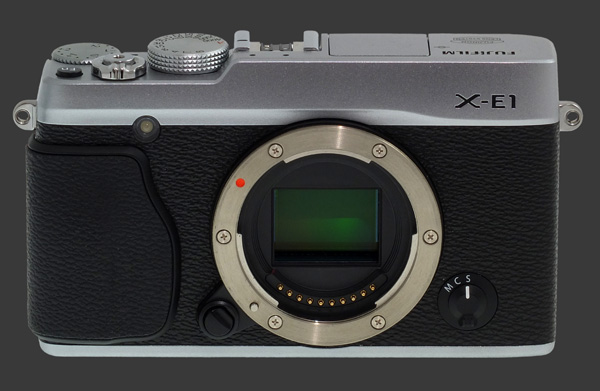
Fuji designed the X-E1 with a strong resemblance to a range-finder camera, giving it a retro look, just like the X-Pro1 before it. Going retro adds a sense familiarity and luxury while embracing more mechanical controls. Such controls predate camera menus and digital cameras as a whole and provide a much more direct interface. The retro design also comes with a boxy shape which is not as comfortable as modern digital cameras.
The front of the X-E1 is quite bare. There is small rubber hand-grip with an AF-assist lamp on one side and a 3-position switch to control the AF drive mode. The options are Single-Shot autofocus, Continuous autofocus and Manual focus.
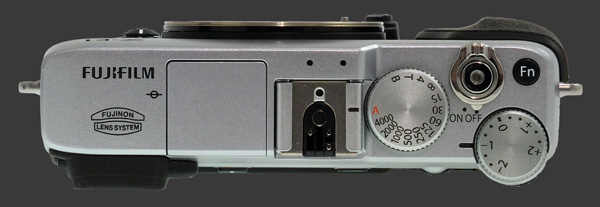
The top of the Fuji X-E1 is distinctly retro. Only the Fn button here gives a hint of modernity. That button can be programed to activate: Multiple Exposure, DOF-Preview, ISO, Self-Timer, Image Size, Image Quality, Dynamic-Range, Film Simulation, White-Balance, AF Mode, Custom Settings Selection, Movie Mode or RAW capture. It is a tough call choosing what to put there but ISO and DOF Preview are the best candidates, since they are most likely to be used quickly. Note that there is NO way to preview Depth-Of-Field without assign it it to the Fn button.
There is an Exposure-Compensation dial, marked from +2 to -2 in 1/3 stops. The dial has good detents and is easily accessible with the camera at eye-level. The retro-price paid here is that exposure increments are hard wired to 1/3 EV and the EC range is minimal. Most modern DSLRs and plenty of SLDs allow ±5 or at least ±3.
The other dial on the top plate is the shutter-speed dial which is marked in full stops from 1/4000s to ¼s. The A position indicates the camera should automatically choose shutter-speed. The T position is for exposure times from ½s to 30s. The B position is for Bulb mode which allows up to one hour exposures when the lens aperture ring is set away from the A position. Otherwise, it exposes for 30s.
A dial on the rear is used to select fractional shutter-speeds, moving ±2/3 EVs from the selected shutter-speed. A bug makes it unfortunately forget the fractional part when entering Playback mode, so shutter-speed needs to be readjusted after reviewing images.
The top plate also shows a standard hot-shoe for external lighting. There the usual focal-plane indicator mark which is surprisingly towards the middle of the body, meaning that an XF-mount camera could be made at least 1cm slimmer. A small built-in popup flash exits through the top plate.
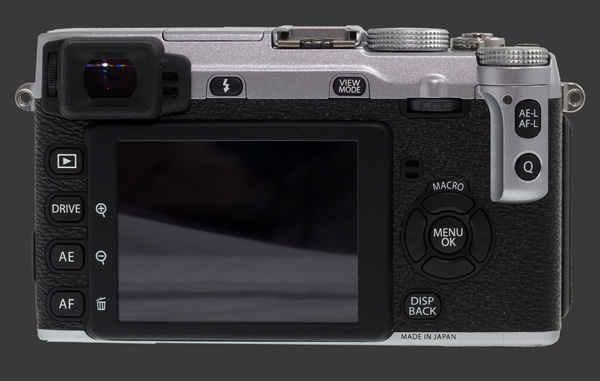
The back of the camera is where all the remaining action is. This side looks more modern, at least if we ignore the fake-leather texture. The position of the viewfinder is ideal for comfort and avoids having to press your nose against the LCD. The square frame around it is made of hard rubber and more comfortable than on the X-Pro1. Right next to it is the Eye-Start Sensor that automatically enables the EVF based on proximity. Once used to one of these, there is no going back! Its sensitivity is just right, although you can disable it off using the View Mode button further right.
More to the right is the control-dial which is sadly unused most of the time. It can be used to enable MF-Assist or change settings in the Quick menu screen which is invoked by pressing the Q button located at the right edge of the camera. Above it is the combined AE-L / AF-L button which be programmed to do either or both.
The remaining controls on the back are fairly typical of a modern advanced digital camera:
- Playback: Enters and exists Playback mode.
- OK / Menu: Enters the menu system and confirms choices.
- 4-Way Controller: Navigates menu and toggles Macro focusing with the Up direction.
- DISP / BACK: Cycles through 3 display mode in Capture mode or 4 modes in Playback mode. Goes back one menu level.
- DRIVE: Chooses among 8 drive modes. Note that Movie Mode and Motion Panorama are both found here.
- AE: Shows a choice of metering patterns: Multi-Segment, Average and Spot. The pattern must be selected using the Left and Right direction of the 4-way controller. It would have been more comfortable to use the control-dial instead.
- AF: Shows the focus-point selection screen in MF and AF-S focus modes, as long as automatic focus-point selection is not chosen.
The back of this Fuji includes a standard 2.8" LCD with an resolution of 460K pixels. The display is sharp and bright with a good refresh rate. Visibility is great both indoors and outdoors. The display is unfortunately not Exposure-Priority at all and neither is the Live-Histogram. This means that exposure is not shown consistently which requires reviewing images more often then necessary.
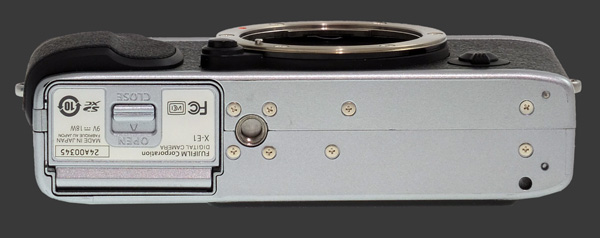
The bottom of the Fuji X-E1 has a metal tripod mount which is neither in-line with the optical axis nor with the center of gravity of the camera. There is also a single compartment door which gives access to both the SDXC card and the Lithium-Ion battery. Since the door is really close to the tripod mount, it is not possible to change memory or battery while the camera is on a tripod or even just fitted with a quick-release plate.
Since the Fuji X-E1 is an expensive camera aimed to advanced photographers, we have high expectations for its ergonomics and usability. After all, the image quality of a missed shot matters very little and so controls are critical to the success of all high-end cameras. While overall handling is certainly adequate, some issues come up frequently:
- No direct buttons for ISO, WB, DOF-Preview and Self-Timer: Yes, one of these can be assigned to the Fn button but these are all important functions. Expect for DOF Preview, all other ones require multiple button presses and turns of the control-dial from the Quick menu system to change.
- No interactive preview of WB: Changing WB is done from a menu or Quick-Menu and not overlaid over the image. This makes it difficult to know which setting to choose.
- Aperture-Ring detents are too soft: It is very easy to knock the ring from the A position to F/16 which is beyond the diffraction limit and often cause very low shutter-speeds to be selected.
- Shutter-Speed needs two dials. As mentioned earlier, the control-dial has to select fractional shutter-speeds but the camera often forgets the faction, notably after entering Playback mode.
- AE-L / AF-L Disabled with MF: In Manual Focus mode, the AE-L / AF-L button performs spot focusing instead, so it is not possible to lock exposure anymore.
- Macro mode needed for non-macro shots: There is a focus limit which prevents lenses from focusing relatively close to the camera. When focusing closer than that limit, autofocus simply fails.
- Uncomfortable strap eyelet: The metal strap eyelet which protrudes from the side of the camera is directly on the way to the shutter-release which is in the retro position, flat on top of the camera.
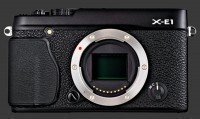 |
Please Support Neocamera
All information on Neocamera is provided free of charge yet running this website is a huge endeavor. Purchases made via affiliate links found throughout the site help keep it running and up-to-date. There is no additional cost to you, so please consider buying via these links to our affilates:
If you found any information on this site valuable and did not purchase via our affiliate links, please considering donating via PayPal:
Any amount will be greatly appreaciated. Thank you for your support!
Fujifilm X-E1 Highlights

Sensor-Size: 24 x 16mm

Actual size when viewed at 100 DPI
| 16 Megapixels Mirrorless | ISO 100-25600 |
| Fujifilm X Mount 1.5X FLM | Shutter 1/4000-30s |
| 0.50" Built-in EVF 2.4 Megapixels (0.62X) | Full manual controls, including Manual Focus |
| Automatic Eye-Start sensor | Custom white-balance with 2 axis fine-tuning |
| 1 Axis Digital Level | Spot-Metering |
| Built-in Dust Reduction | Hot-Shoe |
| 6 FPS Drive, 20 Images | Stereo audio input |
| 1920x1080 @ 24 FPS Video Recording | Lithium-Ion Battery |
| 2.8" LCD 460K Pixels | Secure Digital Extended Capacity |
Updates
2024.04.03

Fujifilm X-T5 Review
Newest Fujifilm flagship boasting a 40 MP APS-C sensor, 5-axis IBIS with 7-stop efficiency, 15 FPS continuous drive, 6.2K Video capture, dual control-dials and dual SDXC UHS-II slots in a sturdy weatherproof and freezeproof body.
2023.11.20

Best Digital Cameras of 2023
Find out which are the Best Digital Cameras of 2023. All the new Mirrorless Digital Cameras from entry-level to high-end professional.
2023.07.10

Fujifilm X-H2 Review
40 Megapixels APS-C Hybrid Mirrorless Digital Camera with 7-stop IBIS. Fastest shutter ever and 8K video capture. Large builtin EVF with 0.8X magnification and 5.8 MP, plus an Eye-Start Sensor. Packed with features and large number of controls in a weatherproof and freezeproof body.
2023.05.07

Sony FE 20-70mm F/4G Review
Review of the unique Sony FE 20-70mm F/4G lens. The optical zoom of this lens spans ultra-wide-angle and medium focal-length coverage, making it one of the most versatile Full-Frame lenses on the market.
2023.01.15

Huion Inspiroy Dial 2 Review
Review of the Huion Inspiroy Dial 2 tablet, a medium sized drawing surface with dual dials and customizable buttons. Connects via USB-C or Bluetooth 5.0 with Windows, Linux and Android support.
2022.12.08

How to Pack for a Photo Trip
Find out how to pack for a travel photography trip, carry your gear safely while meeting airline regulations.
2022.11.13

Best Digital Cameras of 2022
The best digital cameras of 2022. A short list of the most outstanding models in their respective categories. Choose one for yourself or as a gift.
2022.09.21

Pentax DA* 60-250mm F/4 SDM Review
Review of the Pentax DA* 60-250mm F/4 SDM, the constant-aperture telephoto zoom with the highest zoom-ratio on the market.
2022.09.20

Pentax DA* 50-135mm F/2.8 SDM Review
Review of the Pentax DA* 50-135mm F/2.8 SDM, the lightest professional telephoto zoom native to the K-mount.
2022.09.10

Pentax DA* 11-18mm F/2.8 DC AW Review
Review of the Pentax DA* 11-18mm F/2.8 DC AW, the widest professional ultra-wide zoom native to the K-mount.
2021.11.24

50 Gifts Under $50 For Photographers in 2021
50 Gifts photographers will love. All for under $50 USD. 2021 Edition.
2021.11.17

Best Digital Cameras for 2021
Neocamera shows which are the very best Digital Cameras for 2021 in every category: Mirrorless, DSLR, Premium Compact, Ultra-Zoom and Rugged.












